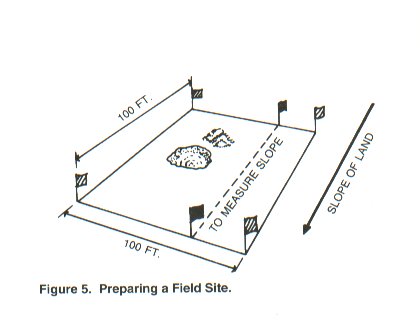
General Contest Rules
1. No talking, comparing, or copying of cards.
2. Clear plastic clipboards are allowed.
3. No water bottles. Water to moisten soil
will be provided as needed.
4. No bubble vile, tape measure, or other
measuring devices are allowed.
5. Contestants can have the following pieces
of equipment:
a. soft lead writing pencil
with a good eraser.
b. knife or nail.
c. towel or rag.
d. contest cards.
6. The land judging handbook shall be used
to resolve contest differences and should be used in setting up and conducting
all contests.
7. Decisions of the judges will be FINAL!
Scoring and Grading
Categories on the scorecard carry varying
values depending on the judges evaluation of its relative importance. The
total points possible on each site are 75 with 45 points from Part I and
30 points from Part II. See the following example. In Part I, items have
only one correct answer, except "Major Factors" must have all appropriate
blocks checked to get credit for the answer. In Part II, the applicable
vegetative, mechanical, and fertilizer practices are checked according
to the judgment of the contestant and other given factors. No partial credit
is awarded.
Use a master sheet to simplify the entry of
individual scores by listing team members vertically and sites horizontally
on the sheet. Circle the low total score for elimination. Team scores can
then be added up quickly.
In the case of a tie in the team score, first
use the score of the 4th individual. If one team has only three members,
the team with the 4th member is the winner. If a tie still exists, use
the scores from Site 1, then use Site 2, Site 3, and Site 4 and the team
with the first largest score can be declared the winner. If this does not
break the tie, the score from Part I, then Part II of Site 1, Site 2, Site
3, and Site 4 can be used. If this procedure fails, all team names with
tied scores can be placed in a hat and drawn for placings. This same procedure
can be used to break individual tied scores.
| Example of Scoring for Land Judging. |
| Part I of Land Judging
Scorecard |
Part II of Land
Judging Scorecard |
| Items | Points | Possible
Practices |
Points |
| A. Texture | - | No. 3 | 6 |
| Surface | 4 | - | - |
| Subsoil | 4 | No. 5 | 4 |
| B. Depth of Soil | 5 | No. 6 | 5 |
| C. Slope | 4 | No. 16 | 6 |
| D. Erosion | 4 | No. 16 | 4 |
| E. Permeability | 5 | No. 25 | 5 |
| F. Surface Runoff | 3 | - | - |
| G. Major Factors | 8 | - | - |
| H. Land Capability | - | - | - |
| Class | 8 | - | - |
| - | Points 45 | Points | 30 |
| - | Total | Points 75 | - |
to see
Land Judging Score Card
click here
size = 217 KB